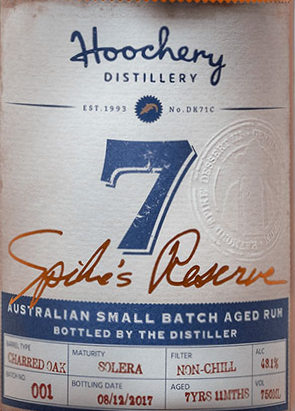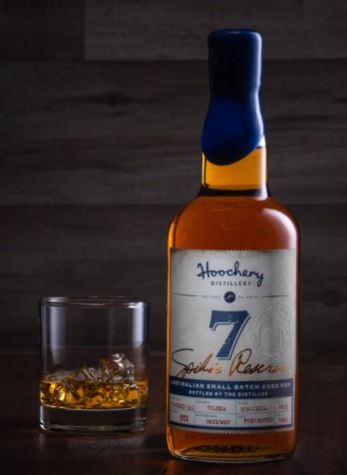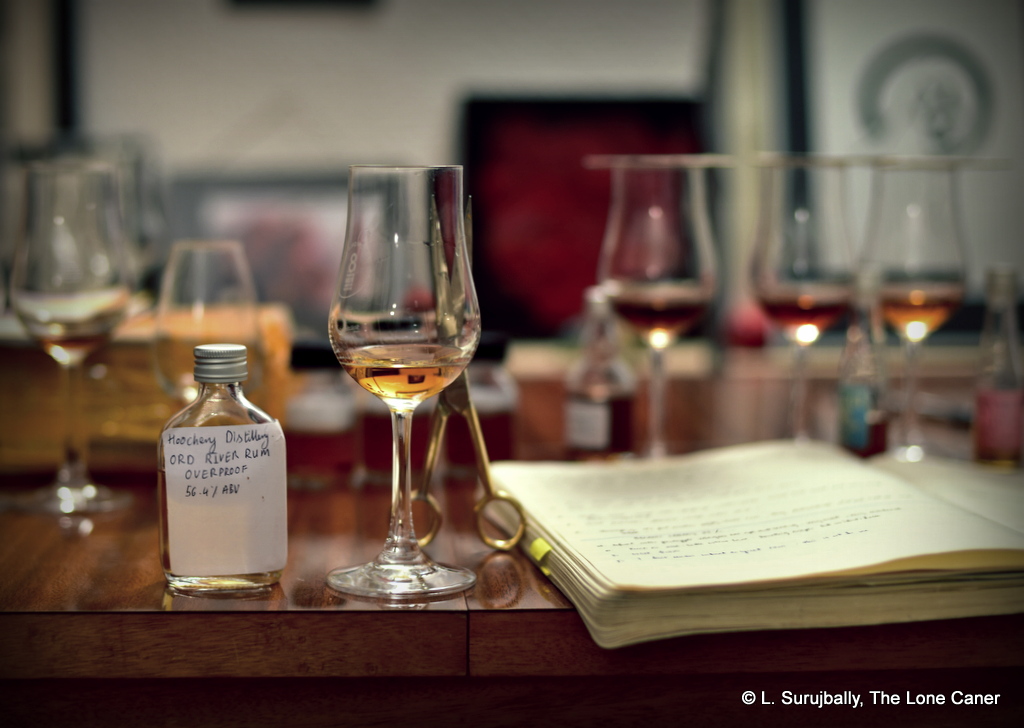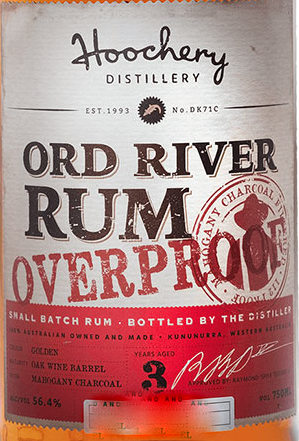Just reading the name of this rum invites questions. Where does the rum come from, with a name like that? Who is Spike? Is there a really a distillery named after the rotgut liquor the word “hooch” represents? In the welter of “cane spirit” new-make unaged rums emerging from the New Australians 1and the lack of many seriously aged rums from Down Under, is there actually one that’s seven years old? What could it possibly be like? Fortunately your fearless (if occasionally clueless) reviewer, possessed of rather more enthusiasm than good sense, has not only been here before but has tried this rum as well, and stands ready (if unsteady) to provide all answers.
First, the distillery: Hoochery Distillery’s name derives from, yes, the word “hooch”, a slang term for moonshine, or illegal liquor, popular during Prohibition. A hoochery is now a trademarked word for a low-end small-scale distillery making (you guessed it) hooch, specifically in Australia. Predating many of the New Australians, the distillery itself was established in 1993 in Western Australia’s remote northern Kimberly outback by an American, Raymond “Spike” Dessert (The Third of His Name). He had been in the area since 1972 and when in the 1990s the Ord River irrigation area permitted sugar cane to be grown, he figured that the combination of tropical climate, sugar cane, and the area’s need to diversify suggested a distillery (since a winery was not an option, there being no vinyards in Western Australia’s far north).
That’s the way the company legend runs, but maybe he just liked rum and couldn’t get any worth drinking there. So, like many independent men in a frontier province, he went about it by making stuff himself, from still to shed to vats, learning as he went along, an ethos the company’s website emphasises. Nearly thirty years further along, Hoochery’s rum range includes four starters (white, spiced, overproof, 2YO premium) and three rather more upscale rums — the Spike’s Reserve series of the 7 YO, 10 YO and 15 YO. All are made with Australian molasses, yeast, local water and a five-day fermentation period — the wash is then run through a self-made double pot still, which keeps things at a low alcohol percentage so as to keep as many flavours in play as possible. The rum we’re looking at today is aged in 300-litre charred oak barrels for seven years, and bottled at 43.1% ABV…it was first released in 2017.
 The rum’s nose is an exercise in distinct if confused complexity: it is redolent of bitter wood resin, salt, rotten fruit and is even a touch meaty. All the subsequent aromas wafting through the profile have these preliminary notes as their background: the apple cider, green grapes, red wine vinegar underlain by light molasses, aromatic tobacco and sweet vanilla. By the time it starts to settle down with puffs of musty caramel, licorice and brine, you know that it’s completely and utterly a rum, just one that vibrates to its own frequency, not yours.
The rum’s nose is an exercise in distinct if confused complexity: it is redolent of bitter wood resin, salt, rotten fruit and is even a touch meaty. All the subsequent aromas wafting through the profile have these preliminary notes as their background: the apple cider, green grapes, red wine vinegar underlain by light molasses, aromatic tobacco and sweet vanilla. By the time it starts to settle down with puffs of musty caramel, licorice and brine, you know that it’s completely and utterly a rum, just one that vibrates to its own frequency, not yours.
Sipping it drives home this point: it has standard tastes of caramel, toffee and sweet brown sugar, and a bag of vanilla (probably from the charred barres that were used in the ageing); and there are some nice hints of stewed apples, peaches in syrup, honey. The problem is that the woodiness, the oakiness, is excessive, and the unsweetened licorice, sawdust, bitter coffee grounds and resin all have too much influence, The sweeter, muskier flavours balance this off as best they can, but it’s not enough. And behind it all is that meatiness, that deep sour funk which some will like and some will not, leading to a dry and tannic finish that’s mostly caramel, toffee, vanilla and overripe fruit.
Aged rums that are fully made in Australia remain relatively scant, with few exceeding ten years of age – Beenleigh has a few good ones and so does the polarising Bundie, with a few others here and there settling around the five year mark. Such indigenous double-digit rums are not yet common enough to make any kind of general statement, the way we can for the unaged whites and their raw distinctiveness. But I hazard that what I’m getting here, with these tastes that jump around like a ‘roo on steroids, is the first inkling of a genuine Australian terroire mixed in with barrel management that still needs some work. It’s possible that the 10YO and the 15YO which Hoochery make will address some of those issues, though I’d have to try them to say for sure. For the moment, the 7 YO is not entirely successful on its own terms, yet remains an intriguing and original rum that can’t be written off just because it’s different and not what we expect. I’d buy it and try it for that alone.
(#903)(79/100) ⭐⭐⭐
Other notes
- As with all the reviewed Australian rums from the 2021 Aussie Advent Calendar, a very special acknowledgement of Mr. And Mrs. Rum’s kindness in sending me a complete set free of charge. Thanks, as always.
- It’s not mentioned on the website, but Mr. Dessert passed away in 2017, just before the labels for the Reserve Batch 001 (of all three ages) arrived. A facsimile of his signature adorns all subsequent batch labels, but that first one, in his memory, remains unsigned. RIP, mate.
- Those labels also present an interesting situation: they say “Aged” 7 years, but under “Maturity” it mentions “Solera”. Since the two are not the same concepts, it begs the question of what kind of ageing the rum underwent. For the moment until my queries get a response, I am taking it on faith that the true age is in fact 7 years, but the reader is advised to be aware of the odd dichotomy, and if anyone knows better, drop me a line.
- The original pot still was installed in 1998, designed a year earlier by Mr. Dessert himself. In 2020 a new, larger pot still was commissioned from Burns Engineering and installed in 2021, and the original was retired.


 The nose begins with metallic, ashy notes right away, damp cardboard in a long-abandoned, leaky musty house. Thankfully this peculiar aroma doesn’t hang around, but morphs into a sort of soya-salt veggie soup vibe, which in turn gets muskier and sweeter over time; it releases notes of bananas and molasses and syrup, before gradually lightening and becoming – surprisingly enough – rather crisp. White fruits emerge – unripe pears and guavas, green apples, gooseberries, grapes. What’s really surprising is the way this all transforms over a period of ten minutes or so from one nasal profile to another. It’s not usual, but it is noteworthy.
The nose begins with metallic, ashy notes right away, damp cardboard in a long-abandoned, leaky musty house. Thankfully this peculiar aroma doesn’t hang around, but morphs into a sort of soya-salt veggie soup vibe, which in turn gets muskier and sweeter over time; it releases notes of bananas and molasses and syrup, before gradually lightening and becoming – surprisingly enough – rather crisp. White fruits emerge – unripe pears and guavas, green apples, gooseberries, grapes. What’s really surprising is the way this all transforms over a period of ten minutes or so from one nasal profile to another. It’s not usual, but it is noteworthy.